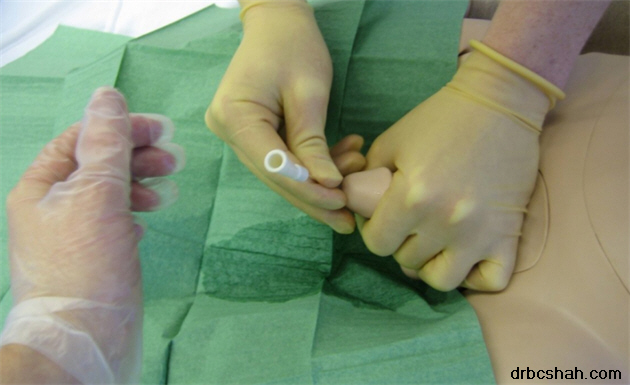Urinary Catheterisation
Introduction
Urinary catheterisation is a medical procedure used to drain and collect urine from the bladder.
A thin flexible tube, known as a catheter, is inserted into the body, usually along the tube through which urine passes (the urethra) or through a hole in the abdomen. The catheter is then guided into the bladder, allowing urine to flow through it and into a drainage bag.
What is it used for?
A urinary catheter can be used on a short- or long-term basis.
It may be required to remove urine from the bladder for a short time:
- When something is stopping a person emptying their bladder in the normal way (for example if the urethra has become blocked by a bladder stone)
- In preparation for some types of surgery, such as a hysterectomy
- To monitor the urine output of someone who is unconscious or recovering from surgery
A urinary catheter may be required for a long time:
- To remove urine from the bladder if a person cannot control their bladder due to nerve damage (this is known as neuropathic bladder)
- To treat urinary incontinence (loss of bladder control) that does not respond to other treatments
If a urinary catheter is required for a long time, a person may be trained to use the catheter in their own home. This is known as self-catheterisation.
Read more about why you might need urinary catheterisation.
Types of catheters
There are two main types of catheter:
- Intermittent catheter, where the catheter is temporarily inserted into the bladder and removed once the bladder is empty
- Indwelling catheter, where the catheter remains in place for many days or weeks
Most people prefer using an indwelling catheter as it is much more convenient and causes less pain than using an intermittent catheter.
However, if a catheter is required on a long-term basis, an intermittent catheter will have to be used. This is because the longer an indwelling catheter is in place, the higher the chance of it causing an infection.
Read more about how catheterisation is carried out.
Risks
The main disadvantage of a urinary catheter is that the equipment can sometimes allow bacteria to enter the body. This can cause an infection in the urethra, bladder or, less commonly, kidneys. These types of infection are collectively known as urinary tract infections.
Urinary tract infections from catheter use are the most common type of infection to affect people staying in hospital, accounting for around a third of cases.
Because of the relatively high risk of infection, a urinary catheter should only be used when there is no other alternative method of emptying the bladder.
Why you might need a urinary catheter
Short-term urinary catheter
A catheter may be used for a short time to:
- Drain the bladder immediately before or after an operation
- Drain the bladder while a woman is giving birth
- Monitor urine output when someone is unconscious and in intensive care
- Clear the bladder of any blood clots and debris following injury to the bladder
Long-term urinary catheter
A catheter may be used for a long time:
- When there is an obstruction in the urinary tract (such as a bladder stone or, in men, a swollen prostate gland) and surgery or medication cannot be used to remove the obstruction immediately
- When someone is confined to bed and too weak to go to the toilet in the normal way
- As a treatment for urinary incontinence if all other types of treatment have failed
Permanent urinary catheter
A catheter may be used permanently if someone has:
- A condition that affects the nervous system, such as spina bifida, cerebral palsy or multiple sclerosis, where they cannot control the muscles and nerves of the bladder
- Serious trauma to the spine, pelvis or bladder, which means they cannot control their bladder in the normal way
Other uses
In some cases, a catheter may be used for reasons other than removing urine from the bladder due to a problem with the urinary tract.
For example, a urinary catheter is occasionally used to obtain a clean urine sample to test for bacterial infections. A clean urine sample is one that has not been contaminated by bacteria from your hands or genitals.
A catheter can also be used to deliver medication directly into the bladder. For example, chemotherapy medications can be placed into the bladder through a catheter to treat bladder cancer.
How a urinary catheter works
Intermittent urinary catheter
An intermittent catheter is inserted long enough to drain your bladder before being removed. It’s usually used a minimum of four times a day.
The catheter is usually inserted into your bladder through the tube along which urine passes out of your body (the urethra). The sterilised catheter is lubricated with a sterile gel, and a local anaesthetic cream may be applied to numb the opening of your urethra.
One end of the catheter is attached to a bag to collect the urine. The other end is inserted into your urethra and guided through it until it enters your bladder and urine starts to flow.
If you are not confined to your bed, the drainage bag can be worn strapped to your leg and hidden under your clothing. If you are confined to your bed, the drainage bag will usually be attached to the lower portion of the bed, near to the floor to help the urine drain downwards.
When the flow of urine stops, the catheter will be moved or rotated. You may need to change positions to ensure that all the urine has been emptied from your bladder. The catheter will then be removed.
A new catheter is normally used each time.
Clean intermittent urinary catheter
Clean intermittent catheterisation (CIC) is a type of catheter that you can be trained to use by yourself at home. It can be useful for people with long-term conditions, such as spina bifida, that disrupt normal bladder function.
An incontinence adviser will teach you how to place the catheter through your urethra and into your bladder.
Urine will flow out of your bladder and through the catheter. You can then guide it into the toilet. To start with, using a catheter can feel a little painful, but this should subside over time.
How often CIC will need to be carried out depends on your circumstances. Some people need to do it once a day, while others will need to do it up to six times a day.
Indwelling urinary catheter
An indwelling urinary catheter is inserted in the same way as an intermittent catheter, but the catheter is left in place until you regain control of your bladder.
If you need to have an indwelling catheter inserted for a long time, a long-term indwelling catheter, such as a Foley catheter, will be used.
A Foley catheter has a small balloon on the end of the tube that is inserted into your bladder. When inflated, the balloon keeps the catheter securely in place.
To prevent infection, the catheter is exchanged for a new one every three to six weeks.
Suprapubic catheterisation
A suprapubic catheter is a type of indwelling catheter. Rather than being inserted through your urethra, the catheter is inserted through a hole in your abdomen, then directly into your bladder.
This procedure is often carried out under a general anaesthetic (you’re asleep throughout the procedure) and is not painful.
A suprapubic catheter is used when there is damage to the urethra, or when a person has a long-term condition and they cannot or do not want to use a clean intermittent catheter.
The catheter is taped to the side of your body and runs down to a collection bag that is strapped to your leg. The catheter will need to be changed every six to eight weeks.
Risks of a urinary catheter
Despite the high hygiene standards in most modern hospitals, around 1 in 10 people who have a catheter get a urinary tract infection (UTI).
The risk of infection increases if your catheter is left in place continuously (an indwelling catheter) or if you use a catheter yourself.
If you use a catheter yourself, it is very important that your care team gives you thorough training in how to use the catheter and the correct hygiene measures.
Symptoms of a UTI include:
- Pain when urinating
- A change in your normal pattern of urinating, such as having to urinate much more than usual
- Passing foul-smelling, cloudy urine
- General symptoms of an infection, such as a high temperature of 38C (100.4F) or above
- Vomiting
Read more about the symptoms of a UTI.
Contact your GP as soon as possible if you think you may have a UTI.
Antibiotics may be prescribed as a precaution to prevent UTIs if you need long-term urinary catheterisation.
Antibiotic gels can also be used to lubricate the catheter.
Other risks
Other risks of using a urinary catheter include:
- Injury to the urethra caused by rough insertion of the catheter
- Narrowing of the urethra due to scar tissue caused by the insertion of the catheter
- Injury to the bladder caused by incorrect insertion of the catheter
- Bladder stones, although these usually only develop after years of catheterisation


 Dr. Bimal Shah is the senior most General & Laparoscopic surgeon in Mira – Bhayandar with largest series of operations. He also consults at Borivali – Dahisar. He believes in ethical practice & is available at only trust hospitals. He passed out from KEM hospital, Mumbai in 1993 and was a lecturer training newer surgeons & medical students till 1998.
Dr. Bimal Shah is the senior most General & Laparoscopic surgeon in Mira – Bhayandar with largest series of operations. He also consults at Borivali – Dahisar. He believes in ethical practice & is available at only trust hospitals. He passed out from KEM hospital, Mumbai in 1993 and was a lecturer training newer surgeons & medical students till 1998. 







